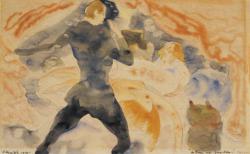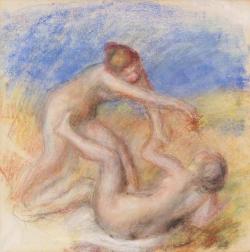Serendip is an independent site partnering with faculty at multiple colleges and universities around the world. Happy exploring!
Crashing the Iconoclast

In class discussion, we all seemed to consider the move of Barnes Foundation a failure, because it defied Barnes’ intention. But after reading The Believing Game which asks us to “scrutinize unfashionable or even repellent ideas for hidden virtues”, I tried to believe that the move had some positive aspects as I re-read my trip.
The minimalistic architecture itself was beautiful. The cement exterior seemed hard and indifferent, but the glass and the shallow water made everything delicate and ephemeral. Before entering the gallery, we had to walk across a large empty space and go through ticket and bag and coat checking, which made me feel unwelcomed. Feeling the expensiveness in the air, I expected the inside display to be one painting per wall, so that the artworks could be given sacred majesty and be enshrined and worshiped.
On the contrary, paintings are placed close together, so close that, in order to keep them from fighting for space, they are separated by huge keys, carved fences, and spearheads. Now that the artworks exist in peace and harmony, they talk and dance with each other. Two pieces of the same painter share similarity or symmetry; a huge portrait of an elderly man surrounded by smaller portraits of children like an old man surrounded by his grandchildren; an ancient African painting looks like a 19th century work; a painting and a sculpture have astonishingly similar patterns.
One painting caught my eyes. Orange and dark blue runs by, through, into each other. Flowing. Floating. Drifting. Like the warm ocean current from the equator meets the cold one from Arctic, crushing, fusing, solving, dissolving, creating home for diverse beautiful oceanic creatures.

Charles Demuth, The Girl with the Golden Eyes
After a while I realized the painting right below this one is a Renoir.

Pierre-Auguste Renoir, Two Nudes
This was the charm of Barnes Foundation, I reckoned. The Demuth painting is very small, and the painter is not a “big name”, so in a normal museum it would be unnoticed. But here, it attracted me more than the Renoir one, because I was undistracted by price or fame or the emphasis it “should” get, and could focus on art itself.
I was shocked when I walked out of the gallery into the large empty space that served wine and cheese and had a jazz band playing. I was so into the warm, cozy, intriguing and inspiring gallery that I forgot it was located in this large, detached building. The contrast made me very uncomfortable.
However, I get from The Believing Game that thinking about different viewpoints helps us better understand our own perspective. From my own experience, I know that being in the US helps me appreciate Chinese culture and my Chinese identity. And the fact that the new Barnes building on the parkway doesn’t fit the gallery and Barnes’ original intention actually helps us understand Barnes’ intention and think further on it.
If the Barnes were still at its old location and operated according to Barnes instruction, we would be angry that he didn’t welcome Bryn Mawr students, and think he’s obstinate, conservative and unfriendly. Even if we visited there, we would probably take its unique style for granted. But seeing the new building full of pretentious wealthy people, we understand Barnes’ concerns and appreciate his ideas.
Also, the old Barnes Foundation is too harmonious. Barnes’ novel idea, its location outside the city, the cute classical building, and limited entrance—everything is in the way it should be. A typical hermit’s whim, just as harmonious as the Art Museum on the parkway. The conflict between Barnes gallery and the new building is what makes everything interesting. I forgot what the building was like during my 2 hours in the gallery, because the artworks and the intricate layout won over the impression of the building. That demonstrates the power of the gallery.
Barnes aimed to be an iconoclast, to challenge the mainstream. So what’s wrong about challenging him?


